You are using an out of date browser. It may not display this or other websites correctly.
You should upgrade or use an alternative browser.
You should upgrade or use an alternative browser.
Tribute to Planet Earth 🌎 ♥️
- Thread starter bjorb
- Start date
Daisugi (台杉) is a Japanese technique related to pollarding, used on Cryptomeria (sugi) trees. The term roughly translates to "platform cedar". Shoots from the base of the tree are pruned so that the trunk stays straight. The technique results in a harvest of straight logs without having to cut down the entire tree. Although originally a forestry management technique, daisugi has also found its way into Japanese gardens.

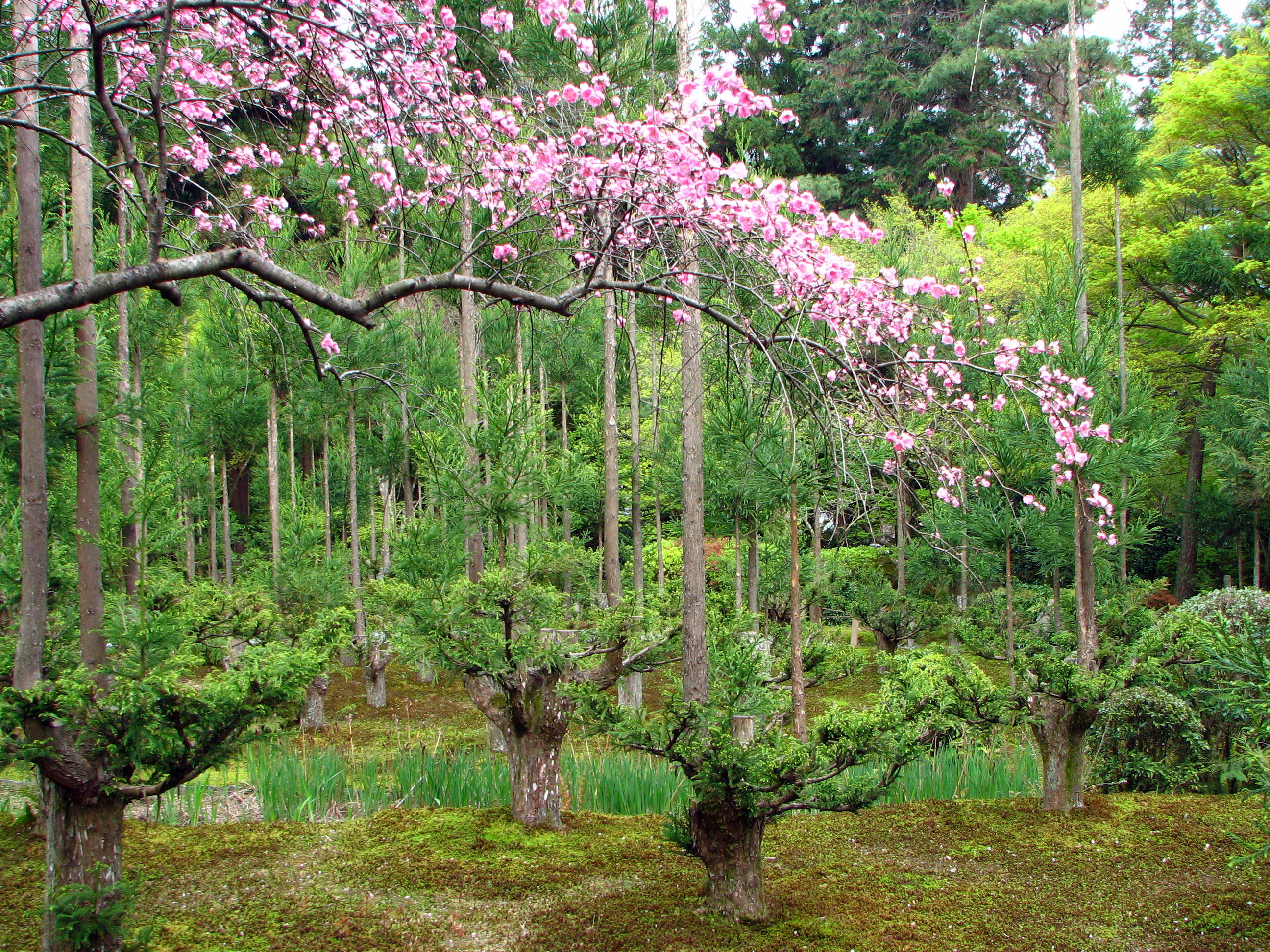


Tsunami de glace dans le fleuve Yenisei La nature nous avertit et le temps passe vite ! #tiredearth
Tsunami de verglas dans l’Ienisseï La nature nous prévient et le temps passe vite ! #tiredearth
Tsunami de verglas dans l’Ienisseï La nature nous prévient et le temps passe vite ! #tiredearth
Au Chili, un arbre vieux de 5.000 ans, "capsule temporelle" de l'adaptation au changement climatique. "C'est un survivant. Aucun autre arbre n'a eu l'occasion de vivre aussi longtemps" https://sciencesetavenir.fr/nature-environnement/plantes-et-vegetaux/au-chili-un-arbre-vieux-de-5-000-ans-capsule-temporelle-de-l-adaptation-au-changement-climatique_170816… via
@Sciences_Avenir
In Chile, a 5,000-year-old tree, "time capsule" of adaptation to climate change.
"It's a survivor. No other tree has had the opportunity to live so long"
https://sciencesetavenir.fr/nature-...psule-temporal-de-l-adaptation-au-changement- climate_170816 via
@Sciences_Avenir
sciencesetavenir.fr
Chile: the oldest cypress in the world reveals its secrets on climate adaptation - Science and...
In Chile, a tree is about to be certified as the oldest specimen on the planet. It was christened "Grand Abuelo"

sciencesetavenir.fr
Chili : le plus vieux cyprès du monde livre ses secrets sur l'adaptation climatique - Sciences et...
Au Chili, un arbre serait en passe d'être certifié comme le plus vieux spécimen de la planète. Il a été baptisé "Grand Abuelo" (arrière-
@Sciences_Avenir
In Chile, a 5,000-year-old tree, "time capsule" of adaptation to climate change.
"It's a survivor. No other tree has had the opportunity to live so long"
https://sciencesetavenir.fr/nature-...psule-temporal-de-l-adaptation-au-changement- climate_170816 via
@Sciences_Avenir
sciencesetavenir.fr
Chile: the oldest cypress in the world reveals its secrets on climate adaptation - Science and...
In Chile, a tree is about to be certified as the oldest specimen on the planet. It was christened "Grand Abuelo"

sciencesetavenir.fr
Chili : le plus vieux cyprès du monde livre ses secrets sur l'adaptation climatique - Sciences et...
Au Chili, un arbre serait en passe d'être certifié comme le plus vieux spécimen de la planète. Il a été baptisé "Grand Abuelo" (arrière-
The Olive Tree of Vouves, estimated to be over 3000 years old. Still producing delicious olives on the isle of Crete in Greece. The exact age of the tree can't be determined because the Heartwood has already rotted away.
Photo courtesy of Carmel Jane Doak

Photo courtesy of Carmel Jane Doak

"Buvez de l'eau de la source où le cheval boit.
Un cheval ne boira jamais de mauvaise eau.
Faites votre lit là où le chat dort.
Mange le fruit qui a été touché par le ver.
Cueillez librement les champignons sur lesquels les insectes s'assoient.
Plantez votre arbre là où la taupe creuse.
Construisez votre maison là où le serpent s'ensoleille.
Creusez votre puits où les oiseaux construisent leurs nids par temps chaud.
Allez dormir et réveillez-vous avec les poules et vous récolterez le grain d'or du jour.
Mangez plus de légumes verts, et vous aurez des jambes solides et un cœur durable.
Nagez plus souvent et vous vous sentirez sur terre comme un poisson dans l'eau.
Regardez le ciel plus souvent et non vos pieds, et vos pensées seront claires et légères.
Gardez le silence plus souvent, parlez moins, et le silence régnera dans votre âme, et votre esprit sera calme et paisible. "
Seraphim de Sarov (Серафи́м Саро́вский), moine et mystique russe (1754-1833)
“Drink water from the spring where the horse drinks. A horse will never drink bad water. Make your bed where the cat sleeps. insects sit. Plant your tree where the mole digs. Build your house where the snake basks in the sun. Dig your well where the birds build their nests in hot weather. Go to sleep and wake up with the chickens and you will harvest the golden grain of the day. Eat more green vegetables, and you will have strong legs and a lasting heart. Swim more often and you will feel on land like a fish in water. Look at the sky more often and not your feet, and your thoughts will be clear and light. Keep silence more often, speak less, and silence will reign in your soul, and your mind will be calm and peaceful." Seraphim of Sarov (Серафи́м Саро́вский), Russian monk and mystic (1754 -1833)

Un cheval ne boira jamais de mauvaise eau.
Faites votre lit là où le chat dort.
Mange le fruit qui a été touché par le ver.
Cueillez librement les champignons sur lesquels les insectes s'assoient.
Plantez votre arbre là où la taupe creuse.
Construisez votre maison là où le serpent s'ensoleille.
Creusez votre puits où les oiseaux construisent leurs nids par temps chaud.
Allez dormir et réveillez-vous avec les poules et vous récolterez le grain d'or du jour.
Mangez plus de légumes verts, et vous aurez des jambes solides et un cœur durable.
Nagez plus souvent et vous vous sentirez sur terre comme un poisson dans l'eau.
Regardez le ciel plus souvent et non vos pieds, et vos pensées seront claires et légères.
Gardez le silence plus souvent, parlez moins, et le silence régnera dans votre âme, et votre esprit sera calme et paisible. "
Seraphim de Sarov (Серафи́м Саро́вский), moine et mystique russe (1754-1833)
“Drink water from the spring where the horse drinks. A horse will never drink bad water. Make your bed where the cat sleeps. insects sit. Plant your tree where the mole digs. Build your house where the snake basks in the sun. Dig your well where the birds build their nests in hot weather. Go to sleep and wake up with the chickens and you will harvest the golden grain of the day. Eat more green vegetables, and you will have strong legs and a lasting heart. Swim more often and you will feel on land like a fish in water. Look at the sky more often and not your feet, and your thoughts will be clear and light. Keep silence more often, speak less, and silence will reign in your soul, and your mind will be calm and peaceful." Seraphim of Sarov (Серафи́м Саро́вский), Russian monk and mystic (1754 -1833)

Andy Goldsworthy, un artiste scultpeur anglais, a organisé les feuilles trouvées à proximité de l’arbre de telle façon pour créer cette illusion d’optique. Aucune retouche logicielle !
Andy Goldsworthy, an English sculptor, arranged the leaves found near the tree to create this optical illusion. No software editing!
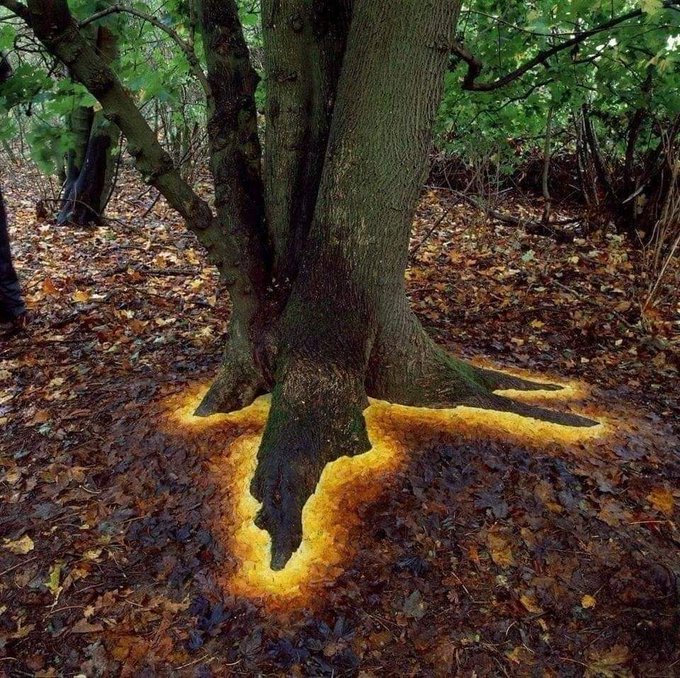
Andy Goldsworthy, an English sculptor, arranged the leaves found near the tree to create this optical illusion. No software editing!

Le vieil arbre de Tule à Oaxaca au Mexique. Il a plus de 2000 ans et possède le plus gros tronc du monde avec une circonférence de 46 mètres. Un véritable géant ancestral !
The old tree of Tule in Oaxaca Mexico. It is over 2000 years old and has the largest trunk in the world with a circumference of 46 meters. A true ancestral giant!

The old tree of Tule in Oaxaca Mexico. It is over 2000 years old and has the largest trunk in the world with a circumference of 46 meters. A true ancestral giant!

La "timidité des arbres", un phénomène mystérieux et fascinant ! C'est en botanique, un phénomène d'allélopathie, encore mal compris de nos jours, par lequel certains arbres maintiennent entre eux, voire entre leurs propres branches maîtresses ou leurs unités architecturales périphériques, une certaine distance, appelée « fente de timidité », typiquement entre 10 et 50 cm bien que ces limites soient peu définies. C'est un peu comme s'ils savaient communiquer entre eux afin de maintenir une sorte de distance sociale. Lorsque vous marchez dans certaines forêts et que vous levez les yeux vers la cime des arbres vous pouvez observer ce phénomène. Dans cette vidéo vous pouvez le voir assez clairement. C'est troublant... La Nature à encore tant de secrets bien gardés Dimitar Karanikolov Photography
The "timidity of trees", a mysterious and fascinating phenomenon! It is in botany, a phenomenon of allelopathy, still poorly understood today, by which certain trees maintain between them, even between their own main branches or their peripheral architectural units, a certain distance, called "shyness gap", typically between 10 and 50 cm although these limits are poorly defined. It's a bit like they know how to communicate with each other in order to maintain a kind of social distance. When you walk in certain forests and look up at the tops of the trees you can observe this phenomenon. In this video you can see it quite clearly. It's disturbing... Nature still has so many well-kept secrets Dimitar Karanikolov Photography
The "timidity of trees", a mysterious and fascinating phenomenon! It is in botany, a phenomenon of allelopathy, still poorly understood today, by which certain trees maintain between them, even between their own main branches or their peripheral architectural units, a certain distance, called "shyness gap", typically between 10 and 50 cm although these limits are poorly defined. It's a bit like they know how to communicate with each other in order to maintain a kind of social distance. When you walk in certain forests and look up at the tops of the trees you can observe this phenomenon. In this video you can see it quite clearly. It's disturbing... Nature still has so many well-kept secrets Dimitar Karanikolov Photography
Et si en effet ils savaient communiquer entre eux ?
Shot De Savoir
@Shot_de_savoir
30 avr.
Sciences Les premiers enregistrements d’ultrasons émis par des plantes stressées révèlent une nouvelle forme de communication. #Science #Nature source: https://cell.com/cell/fulltext/S0092-8674(23)00262-3
What if they could indeed communicate with each other?
Shot Of Knowledge
@Shot_of_knowledge
Apr 30
Science The first ultrasound recordings emitted by stressed plants reveal a new form of communication. #Science #Nature source: https://cell.com/cell/fulltext/S0092-8674(23)00262-3
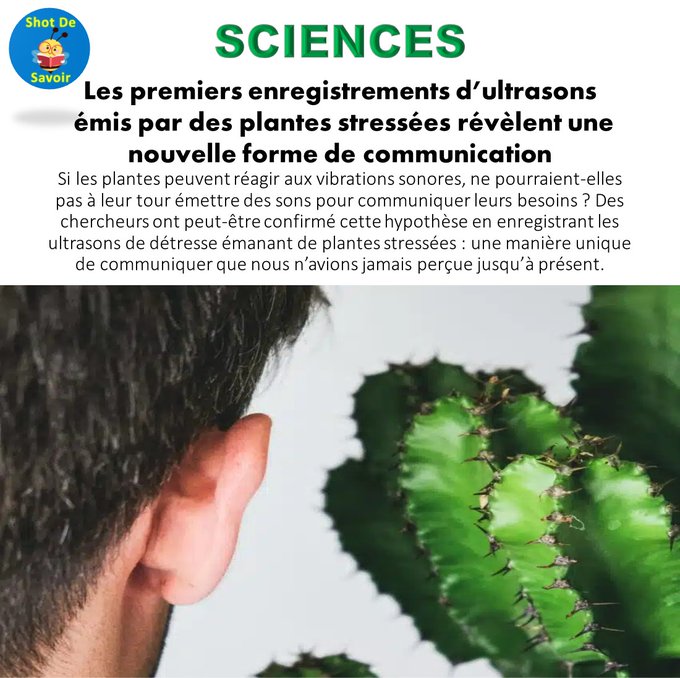
Shot De Savoir
@Shot_de_savoir
30 avr.
Sciences Les premiers enregistrements d’ultrasons émis par des plantes stressées révèlent une nouvelle forme de communication. #Science #Nature source: https://cell.com/cell/fulltext/S0092-8674(23)00262-3
What if they could indeed communicate with each other?
Shot Of Knowledge
@Shot_of_knowledge
Apr 30
Science The first ultrasound recordings emitted by stressed plants reveal a new form of communication. #Science #Nature source: https://cell.com/cell/fulltext/S0092-8674(23)00262-3

Observez le mouvement des plantes en timelapse sur une journée de 24h. On a souvent du mal à classer les végétaux parmi les êtres vivants dans notre esprit et pourtant voyez par vous-mêmes... Et en voyant cela, on regrette même d'avoir arraché toutes ces feuilles et ces fleurs dans nos jardins quand on était petits Voilà qui nous amène donc à réfléchir et à voir la vie d'une autre manière. À reconsidérer l'existence. C'est fascinant presque magique
Observe the movement of plants in timelapse over a 24-hour day. It is often difficult to classify plants among living beings in our minds and yet see for yourselves... And seeing this, we even regret having torn off all these leaves and flowers in our gardens when we were small This is what leads us to reflect and see life in another way. To reconsider existence. It's fascinating almost magical
Observe the movement of plants in timelapse over a 24-hour day. It is often difficult to classify plants among living beings in our minds and yet see for yourselves... And seeing this, we even regret having torn off all these leaves and flowers in our gardens when we were small This is what leads us to reflect and see life in another way. To reconsider existence. It's fascinating almost magical
Ces arbres ont poussé dans une forêt près de Gryfino, en Pologne. La cause exacte de la courbure est inconnue, bien qu’il existe différentes hypothèses. En voici deux d’entre elles. La première est que de fortes chutes de neige auraient alourdi les arbres pendant qu’ils poussaient, les faisant grandir de travers. Mais cette théorie n’explique pas pourquoi d’autres arbres de la région ne sont pas concernés, ni pourquoi ceux courbés le sont d’une manière aussi uniforme. La deuxième hypothèse la plus connue, qui semble d’ailleurs la plus probable, est que les arbres auraient été intentionnellement modifiés par les agriculteurs de la ville voisine il y a longtemps. Ils auraient été plantés vers 1930. À cette époque, il n’était pas rare pour les agriculteurs de manipuler les jeunes arbres pour leur donner des formes qui faciliteraient leur utilisation pour les matériaux de construction. Les agriculteurs auraient donc courbé les arbres au fur et à mesure qu’ils poussaient, ce qui expliquerait pourquoi tant d’arbres ont une forme aussi homogène, et que tous ne sont pas concernés.
These trees grew in a forest near Gryfino, Poland. The exact cause of curvature is unknown, although there are different hypotheses. Here are two of them.
The first is that heavy snowfall would have weighed down the trees as they grew, causing them to grow crooked. But this theory doesn't explain why other trees in the area aren't affected, or why bent ones are so uniformly bent.
The second best-known hypothesis, which incidentally seems the most likely, is that the trees were intentionally modified by the farmers of the neighboring town a long time ago. They are said to have been planted around 1930. At that time, it was not uncommon for farmers to manipulate young trees into shapes that would facilitate their use for building materials. The farmers would therefore bend the trees as they grew, which would explain why so many trees have such a homogeneous shape, and that not all of them are affected.
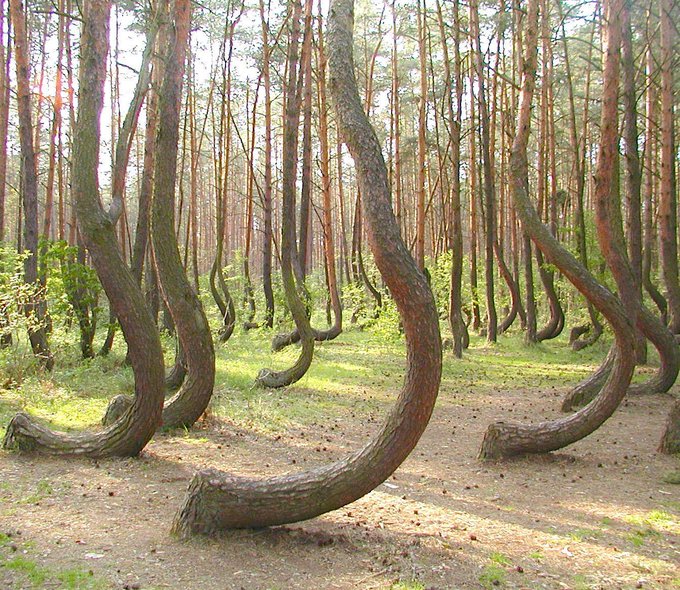
These trees grew in a forest near Gryfino, Poland. The exact cause of curvature is unknown, although there are different hypotheses. Here are two of them.
The first is that heavy snowfall would have weighed down the trees as they grew, causing them to grow crooked. But this theory doesn't explain why other trees in the area aren't affected, or why bent ones are so uniformly bent.
The second best-known hypothesis, which incidentally seems the most likely, is that the trees were intentionally modified by the farmers of the neighboring town a long time ago. They are said to have been planted around 1930. At that time, it was not uncommon for farmers to manipulate young trees into shapes that would facilitate their use for building materials. The farmers would therefore bend the trees as they grew, which would explain why so many trees have such a homogeneous shape, and that not all of them are affected.

Elle envoûte rien que par son nom « Red Love », la pomme à chair rouge n’a rien de distinct aux autres pommes vues de l’extérieur. Mais lorsqu’on la coupe en deux, c’est là qu’on découvre sa chair rouge ressemblant à celle d’une tomate.
It bewitches just by its name "Red Love", the red-fleshed apple has nothing distinct from other apples seen from the outside.
But when you cut it in half, that's when you discover its red flesh resembling that of a tomato.
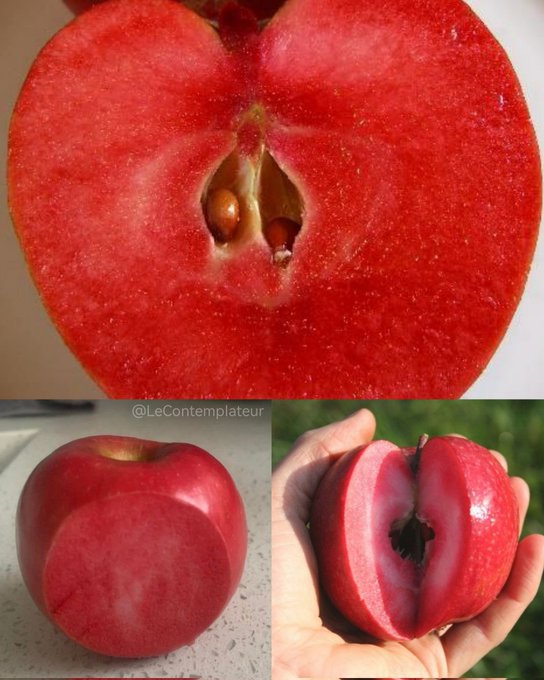
It bewitches just by its name "Red Love", the red-fleshed apple has nothing distinct from other apples seen from the outside.
But when you cut it in half, that's when you discover its red flesh resembling that of a tomato.

Le magnifique Dragonier de Socotra au Yémen . Ces arbres peuvent vivre plusieurs millénaires et sont endémiques. Ils détiennent leur force et leur résilience du fait de leur adaptation à un climat extrêmement aride. Il est aussi nommé "arbre de vie" à cause de son apparence qui lui donne l'impression d'avoir des racines dans le sol et dans le ciel. On prête à sa résine des propriétés médicinales. Surnommé le joyau de la péninsule arabe, c'est un arbre entouré de mysticisme. Daniel kordan
The magnificent dragon tree of Socotra in Yemen. These trees can live for several millennia and are endemic. They derive their strength and resilience from their adaptation to an extremely arid climate. It is also called "tree of life" because of its appearance which gives the impression of having roots in the ground and in the sky. Its resin is believed to have medicinal properties. Nicknamed the Jewel of the Arabian Peninsula, it is a tree shrouded in mysticism. Daniel Kordan
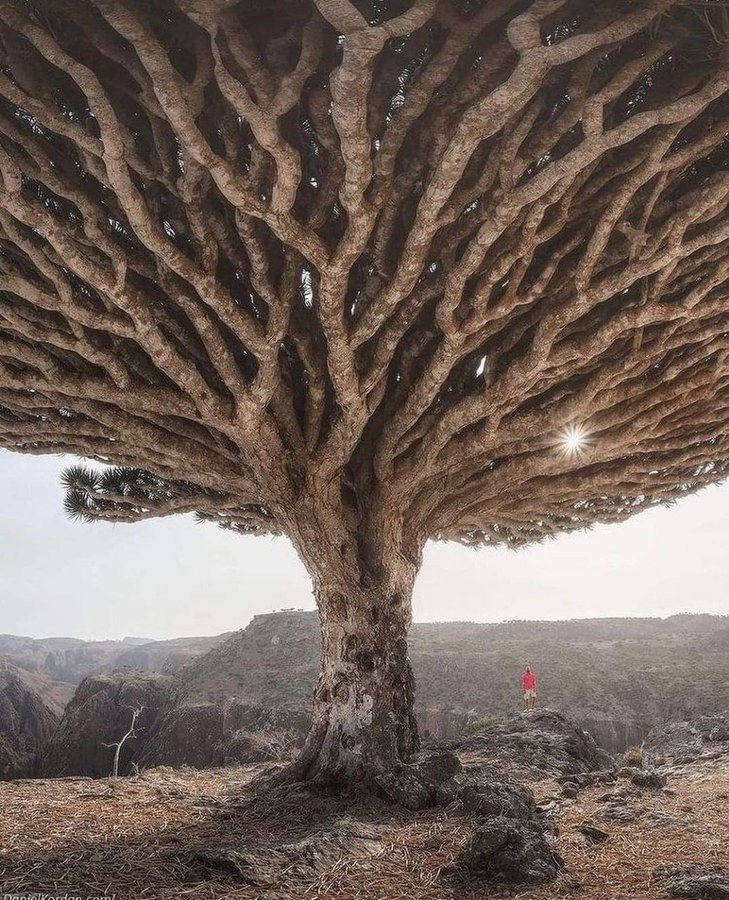
The magnificent dragon tree of Socotra in Yemen. These trees can live for several millennia and are endemic. They derive their strength and resilience from their adaptation to an extremely arid climate. It is also called "tree of life" because of its appearance which gives the impression of having roots in the ground and in the sky. Its resin is believed to have medicinal properties. Nicknamed the Jewel of the Arabian Peninsula, it is a tree shrouded in mysticism. Daniel Kordan



